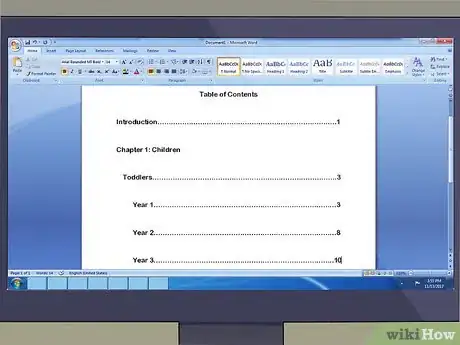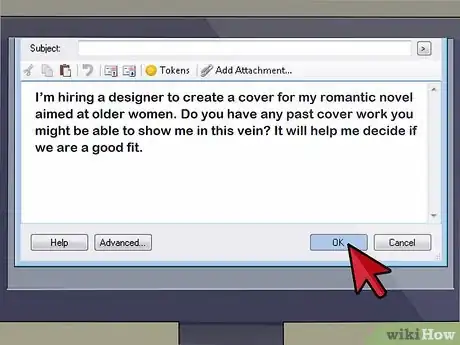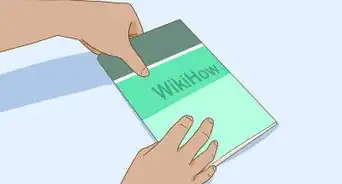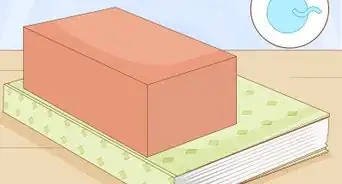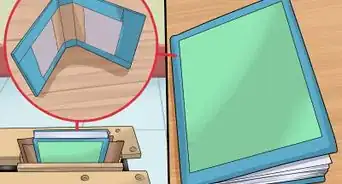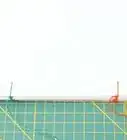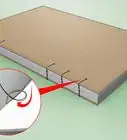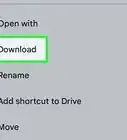This article was co-authored by Alicia Cook. Alicia Cook is a Professional Writer based in Newark, New Jersey. With over 12 years of experience, Alicia specializes in poetry and uses her platform to advocate for families affected by addiction and to fight for breaking the stigma against addiction and mental illness. She holds a BA in English and Journalism from Georgian Court University and an MBA from Saint Peter’s University. Alicia is a bestselling poet with Andrews McMeel Publishing and her work has been featured in numerous media outlets including the NY Post, CNN, USA Today, the HuffPost, the LA Times, American Songwriter Magazine, and Bustle. She was named by Teen Vogue as one of the 10 social media poets to know and her poetry mixtape, “Stuff I’ve Been Feeling Lately” was a finalist in the 2016 Goodreads Choice Awards.
There are 11 references cited in this article, which can be found at the bottom of the page.
This article has been viewed 18,247 times.
Writing a book is no easy task, but designing it can seem even more daunting. Whether you’re self-publishing a children’s book or a novel, a well-designed book engages your readers and showcases your writing. By formatting the interior, conceptualizing a cover, and hiring a graphic designer, you can design a professional and eye-catching book in no time.
Steps
Formatting the Interior
-
1Create a table of contents with page numbers. Add a table of contents at the beginning of your self-published book to help readers navigate the content. List the chapters in chronological order with a hard return between each, so each one takes up one line. Then, double-space them. Include a dotted line running from the end of each chapter name (justified left) to its corresponding page number (justified right).[1]
- If your chapters are divided into sections, create a line and corresponding page number for the start of each section as well as each chapter.
- For example, if your book is about children, you might have a section titled “Toddlers” made up of chapters on “Year 1,” “Year 2,” and “Year 3.” In the table of contents, include a page number on which the “Toddlers” section begins. This way, people who want to read about this entire stage of life can flip to that part of your book.
- For the ease of reading, try to keep chapter and section names to one line.
-
2Number your pages. Use Arabic numerals to number the pages of your self-published book beginning on the first page of chapter one. Page 1 should be a right hand page across from a blank left page. Use Roman numerals to number the pages of any front matter, such as a dedication or a table of contents, appearing before that.[2]
- Using this method, page 1 and all right-hand pages are odd pages, while page 2 and all left-hand pages are even pages.
- Center the page numbers at the bottom of the page for the easiest page-numbering option. If you want to justify your page numbers left or right, ensure all even pages are justified left, and all odd pages are justified right.
Advertisement -
3Choose serif-less fonts that print well. Skip core operating-system fonts, such as Arial, Calibri, Cambria, Candara, Comic Sans, Constantia, Courier, Georgia, Helvetica, Lucida, Palatino, Trebuchet, or Verdana for your self-published book. These fonts are optimized for computer display, so many of their graphic nuances are lost when printed.[3]
-
4Double-space your work for readability. Include scene divisions to help break up blocks of text, if needed. Single-spacing your work can make it difficult for your reader to follow along.[6]
- Changing scenes or character points of view are good places to include a division for readability within a chapter.
- These breaks are often set off with three asterisks (***) and a few blank lines on either side.
-
5Select a trim size. Set the page dimensions of your manuscript to those of your final book, also called the trim size. The appropriate trim size for your self-published book depends upon the type of book you are creating and its length.[7]
- Most novels, non-fiction works, and books of poetry have a trim size of 5.5 in x 8.5 in (13.97 cm x 21.59 cm) or 6 in x 9 in (15.24 x 22.86 cm). Authors of longer works may prefer the slightly larger size for easier readability.[8]
- For art books, yearbooks, and children’s books, a trim size of 8.5 in x 11 in (21.59 cm x 27.94 cm) in a portrait or landscape orientation is typical. A landscape orientation is usually chosen only if a work has many photos.[9]
-
6Select appropriate margins for your trim size. Create margins that are the same on the right-hand side, top edge, and bottom edge with a larger margin on the left-hand side for binding. Margin sizes depend upon the trim size (book size) you select.[10]
- For books with a trim size of 5.5 in x 8.5 in (13.97 cm x 21.59 cm) or 6 in x 9 in (15.24 x 22.86 cm), typical margin sizes are 0.75 in (19 mm) for the 3 exposed edges and 1 in (25 mm) for the left-hand margin.[11]
- For books with a trim size of 8.5 in x 11 in (21.59 cm x 27.94 cm), typical margin sizes are 1 in (25 mm) for the 3 exposed edges and 1.125 in (28.5 mm) for the left-hand margin. These margins are the same whether the book is oriented in landscape or portrait mode.[12]
Conceptualizing a Cover
-
1Refine your working title into a final one. Reread your final manuscript with your working title in mind. Does it still fit? Strive for a final title that is concise and compelling. A title should sum up the message of your book in a way that piques interest but is not excessively mysterious. Include the title in a larger font on the cover of the book.[13]
- Google your prospective title to make sure it isn’t already taken.
- Sharpen your title idea by using precise nouns and active verbs. “Sadness beside the Tree” is less compelling than “Longing under the Maple.”
- Keep key plot points or spoilers a secret with your title.
- If there is a subheading to your title, put it below the title in a smaller font. The exact point size of each will depend upon the look you’re going for and the physical size of the book. Seek out at examples at your local bookstore to get inspiration.
- If you’ll be hiring a graphic designer to create your cover, simply write down your final title name. You designer will incorporate your title into your design.
-
2Include your name. Add your byline, meaning “by Your Name,” on the cover of your self-published book underneath the title in a smaller font. If you want to write the book under a pseudonym or pen name, include that name in the byline instead of your own.
-
3Include a synopsis on the back. Write a brief teaser for your book that supplies key information, such as the main characters, a sneak peek at the plot, and the setting, as well as a hint at how these themes unite together. It should be concise (not longer than a paragraph) and written from a third person perspective.[14]
-
4Browse covers at your local bookstore for cover art ideas. Seek out books in your genre to note what fonts, images, and colors are popular right now. Bring a notepad, so you can write down any ideas you get as you look. Strive for the same feel of best-selling books in your genre to make the most impact.
- Bring a camera to take photos of any covers that inspire you.
- Pay attention to color combinations and images that grab your attention. Your potential readers will likely feel the same way.
- The art director of the New York Times Book Review selects the best covers from each year’s crop of books. Review this list for a professional’s opinion of the most compelling recent designs for different genres: https://www.nytimes.com/interactive/2016/books/review/book-covers.html
-
5Go for a symbolic approach when selecting cover images for your book. Refrain from being too literal or expository in your cover design. Including too many images can be busy and confusing, or worse, look boring and outdated.
- For example, if your self-published book is about polygamy, rather than having a cover with many brides, a stressed-looking groom, and lots of children, opt for a cover with multiple wedding bands on a finger to sum up the idea.
- If your self-published book is about balancing children and work, a pacifier sitting on a calculator could be an effective symbolic representation.
- Everyone remembers those cheesy murder-mystery covers: A detective behind a door with a flashlight, inset images of the villain, a secret trunk, and other mystery paraphernalia. Steer clear of that cluttered look!
Hiring a Graphic Designer
-
1View graphic designer profiles on freelance marketplaces. Browse freelance marketplaces, such as UpWork or PeoplePerHour, to find potential graphic designers taking on book work. Create a list of favorites based on their relevant experience, listed availability, and the scope of your project.[15]
- Determine if you want help formatting and adding design elements to your book’s interior or just creating the cover.
- Most marketplaces ask freelancers to list an hourly rate. Take this number into account as you budget for your design project.
- If you have questions that come up about your project while you browse profiles, write those down to discuss with the designers later.
-
2Ask for copies of past work or a portfolio. Write your shortlist of potential candidates a personal message confirming their availability and describing the scope of assistance you are seeking. Based on this information, ask each designer to send you a portfolio of relevant past work that you can consider in making a hiring decision.
- You might say, “I’m hiring a designer to create a cover for my self-published romantic novel aimed at older women. Do you have any past cover work you might be able to show me in this vein? It will help me decide if we are a good fit.”
- Some designers may self-select out of the hiring process if they feel they aren’t a good fit for your project or are too busy.
- If someone you really like isn’t available, you can always ask, “Do you have a trusted fellow designer who might be interested in a project like this?”
-
3Pay the finalists to perform a small, skills-based design test. Ask each of the designers if they might participate in a short test to demonstrate their design skills for compensation. You can get a feel for their work and communication style firsthand.
- Ask the designers to do a test other than a mock up of your cover. The goal is not to get your project out of the test for a lesser fee but to determine the skill level of the various candidates.
- Give the designers a set of creative and formatting guidelines to follow for the test. For example, you could ask them to design a bookmark of specific dimensions that reflects the mood of your book. Allow them some room for creativity!
-
4Interview multiple designers to make your final selection. Narrow your field down to 2 or 3 potential designers. Coordinate to interview each either over the phone or on a video call. This is a great opportunity to ask questions about their portfolio, further describe your project to gauge their interest, and discuss the budget.
- Important questions to ask include: “How do you incorporate client feedback into your designs?” and “How do you see our collaboration working over the design process?” Ask how long a project of this scope will take them and how many rounds of feedback are included in their design fee, if there is a limit.
- Take note of your rapport with each designer. You’re apt to have a better working relationship with someone you get along with and can communicate with easily.
- Hire the designer you feel the best about based on their skills, experience, availability, and price.
-
5Discuss your design objectives and project goals with your designer. Include any relevant observations from your trips to the bookstore. Email your designer a copy of your manuscript to read, as well. This background information will help them execute a design that resonates with the tone of your book and the design aesthetic that appeals to you.[16]
- If you’re concerned about providing a copy of your unpublished book to the designer, ask them to sign a nondisclosure agreement.
- If it’s within the scope of the design project, ask your designer to double-check the formatting of your book’s interior to make sure it is print-ready.
Community Q&A
Did you know you can get expert answers for this article?
Unlock expert answers by supporting wikiHow
-
QuestionCan I design my own book cover?
 Alicia CookAlicia Cook is a Professional Writer based in Newark, New Jersey. With over 12 years of experience, Alicia specializes in poetry and uses her platform to advocate for families affected by addiction and to fight for breaking the stigma against addiction and mental illness. She holds a BA in English and Journalism from Georgian Court University and an MBA from Saint Peter’s University. Alicia is a bestselling poet with Andrews McMeel Publishing and her work has been featured in numerous media outlets including the NY Post, CNN, USA Today, the HuffPost, the LA Times, American Songwriter Magazine, and Bustle. She was named by Teen Vogue as one of the 10 social media poets to know and her poetry mixtape, “Stuff I’ve Been Feeling Lately” was a finalist in the 2016 Goodreads Choice Awards.
Alicia CookAlicia Cook is a Professional Writer based in Newark, New Jersey. With over 12 years of experience, Alicia specializes in poetry and uses her platform to advocate for families affected by addiction and to fight for breaking the stigma against addiction and mental illness. She holds a BA in English and Journalism from Georgian Court University and an MBA from Saint Peter’s University. Alicia is a bestselling poet with Andrews McMeel Publishing and her work has been featured in numerous media outlets including the NY Post, CNN, USA Today, the HuffPost, the LA Times, American Songwriter Magazine, and Bustle. She was named by Teen Vogue as one of the 10 social media poets to know and her poetry mixtape, “Stuff I’ve Been Feeling Lately” was a finalist in the 2016 Goodreads Choice Awards.
Professional Writer
References
- ↑ https://helpx.adobe.com/indesign/using/creating-table-contents.html
- ↑ http://libguides.lib.msu.edu/c.php?g=97090&p=908734
- ↑ http://www.adamsdrafting.com/typography-revisiting-my-choice-of-calibri/
- ↑ https://www.washingtonpost.com/blogs/compost/wp/2015/04/29/study-finds-times-new-roman-is-bad-for-resumes-what-other-fonts-should-you-avoid/?utm_term=.a4d5efa66ac8
- ↑ http://www.artbookbindery.com/font-sizes.php
- ↑ https://support.office.com/en-ie/article/Double-space-the-lines-in-a-document-9c026fce-5231-4508-b236-5cd3a4953469
- ↑ http://www.artbookbindery.com/choosing-a-page-size.php
- ↑ http://www.artbookbindery.com/choosing-a-page-size.php
- ↑ http://www.artbookbindery.com/choosing-a-page-size.php
- ↑ http://www.artbookbindery.com/margins-and-bleeds.php
- ↑ http://www.artbookbindery.com/margins-and-bleeds.php
- ↑ http://www.artbookbindery.com/margins-and-bleeds.php
- ↑ https://owl.english.purdue.edu/owl/resource/704/01/
- ↑ http://www.writersdigest.com/writing-articles/by-writing-goal/get-published-sell-my-work/your-guide-to-an-effective-novel-synopsis
- ↑ https://www.americanexpress.com/us/small-business/openforum/articles/how-to-hire-a-freelance-graphic-designer/
- ↑ https://www.americanexpress.com/us/small-business/openforum/articles/how-to-hire-a-freelance-graphic-designer/
About This Article
To design the interior of a book, start with a table of contents, followed by a blank page. Then, have page 1 be the right-hand page after the blank page. Number all of the pages in your book, starting with the first page of the first chapter, and center the numbers at the bottom of each page. When you're choosing a font, go with a serif-less font since they print better, and make it 10-12 point. You should also double space your text so it's easier to read. For tips on how to design a book cover, scroll down!
